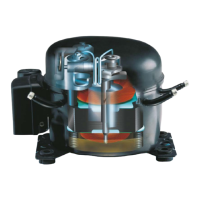56
32.
TESTING
Hermetic refrigerating systems must be tight. If a household appliance is to function over a reasonable
lifetime, it is necessary to have leak rates below 1 gram per year. High quality leak testing equipment is
thus required. All connections must be tested for leaks with leak testing equipment. This can be done using
electronic leak testing equipment.
The discharge side of the system (from discharge connector to the condenser and to the drier) must be
tested with the compressor running. The evaporator, the suction line, and the compressor must be tested
during idle periods and equalized pressure.
If refrigerant R600a is used, leak testing should be done by means other than the refrigerant, e.g. helium,
as the equalizing pressure is low, so often below ambient air pressure. Thus, leaks would not be detectable.
Before leaving a system it must be checked that cooling down of the evaporator is possible and that the
compressor operates satisfactory on the thermostat. For systems with a capillary tube as a throttling device,
it is important to check that the system is able to pressure equalize during standstill periods. The low start-
ing torque compressor must also be able to start the system without causing trips on the motor protector.
In a situation where the whole system has to be tested with high pressure, we recommend a test with nitro-
gen, dry air or helium. You should not exceed pressure of 10 bar on the low pressure side of the compressor.
For the high pressure side, 32 bar is the limit. Ensure that all parts of the cooling system withstand the
pressure. We can only take assigned responsibility for the compressor.
32.1
Testing of the
appliance

